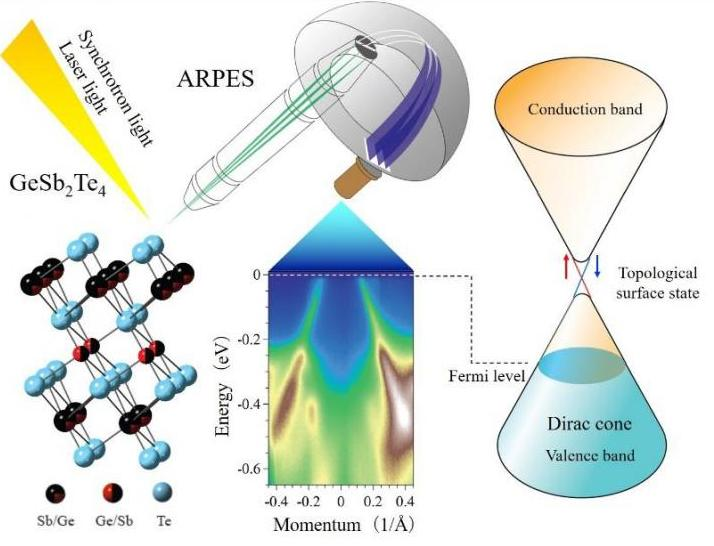Aug 11 2020
Dirac electrons, or electrons that act as if they have no mass, have been discovered in a compound used to make rewritable disks such as CDs and DVDs.
 (Left) Crystal structure for the intermixed crystalline phase of the phase-change compound GeSb2Te4. (Middle) Angle-resolved photoemission spectrum of crystalline GeSb2Te4 by showing the linearly dispersive band crossing the Fermi level. (Right) Schematic band structure of the crystalline GeSb2Te4 based on this study. Image Credit: Akio Kimura, Hiroshima University.
(Left) Crystal structure for the intermixed crystalline phase of the phase-change compound GeSb2Te4. (Middle) Angle-resolved photoemission spectrum of crystalline GeSb2Te4 by showing the linearly dispersive band crossing the Fermi level. (Right) Schematic band structure of the crystalline GeSb2Te4 based on this study. Image Credit: Akio Kimura, Hiroshima University.
The discovery of such “massless” electrons in the phase-change material could open the door for faster electronic devices. The international research team reported the study findings on July 6th, 2020, in ACS Nano, a journal of the American Chemical Society.
The GeSb2Te4 compound is a phase-change material, that is, its atomic structure changes from amorphous to crystalline upon heating. Each of these structures is reversible and exhibits distinct properties, which makes the compound a perfect material for use in electronic devices in which information can be written and rewritten multiple times.
Phase-change materials have attracted a great deal of attention owing to the sharp contrast in optical and electrical properties between their two phases. The electronic structure in the amorphous phase has already been addressed, but the experimental study of the electronic structure in the crystalline phase had not yet been investigated.
Akio Kimura, Study Author and Professor, Department of Physical Sciences, Graduate School of Science and Graduate School of Advanced Science and Engineering, Hiroshima University
The team identified that Dirac electrons are found in the crystalline phase of GeSb2Te4, which implies that its behavior is quite similar to graphene—a conducting material that includes a single layer of carbon atoms.
Moreover, they discovered that the crystalline structure’s surface shares its characteristics with a topological insulator, in which the internal structure is found to be static while the surface acts as a conductor of electricity.
The amorphous phase shows a semiconducting behavior with a large electrical resistivity while the crystalline phase behaves like a metallic with a much lower electrical resistivity. The crystalline phase of GeSb2Te4 can be viewed as a 3D analogue of graphene.
Munisa Nurmamat, Study Author and Assistant Professor, Department of Physical Sciences, Graduate School of Science and Graduate School of Advanced Science and Engineering, Hiroshima University
Nurmamat and Kimura state that although researchers already consider graphene as a high-speed conducting material, its intrinsically low on- and off-current ratio restricts its applications in electronic devices. GeSb2Te4 is a 3D version of graphene and integrates speed with the flexibility to design the next generation of electrical switching devices.
This study was financially supported by the Japan Society for the Promotion of Science, the Tomsk State University competitiveness improvement program, Saint Petersburg University, the Russian Science Foundation, and the Ministry of Education and Science of the Russian Federation.
Journal Reference
Nurmamat, M., et al. (2020) Topologically Nontrivial Phase-Change Compound GeSb2Te4. ACS Nano. doi.org/10.1021/acsnano.0c04145.